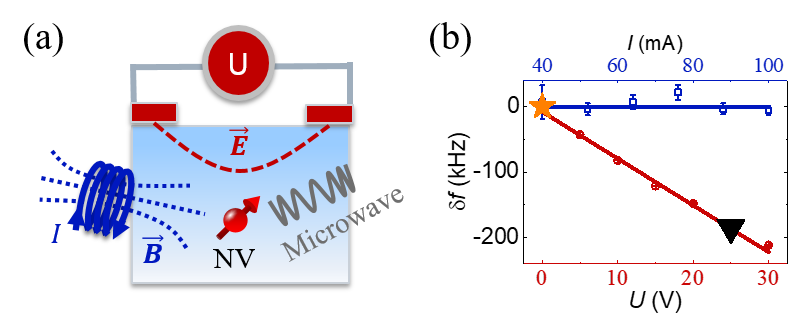Researchers Realize Nanoscale Electrometry Based on Magnetic-Field-Resistant Spin Sensor
A team led by Prof. DU Jiangfeng, Prof. SHI Fazhan and Prof. WANG Ya from University of Science and Technology of China (USTC) of the Chinese Academy of Sciences (CAS) proposed a robust electrometric method utilizing continuous dynamic decoupling (CDD) technique, where the continuous driving fields provide a magnetic-field-resistant dressed frame. The study was published in Physical Review Letters on June 19.
Characterization of electrical properties and comprehension of the dynamics in nanoscale become significant in the development of modern electronic devices, such as semi-conductor transistors and quantum chips, especially when the feature size has shrunk to several nanometers.
The nitrogen-vacancy (NV) center in diamond, an atomic-scale spin sensor, has shown to be an attractive electrometer. Benefited from the in situ compatibility with diamond-based semiconductor devices and the potential of electric-field imaging by combing the scanning technology, electrometry by using the NV center would advantage various sensing and imaging applications. However, its natural susceptibility to the magnetic field hinders effective detection of the electric field.
NV center is a defect in diamond, which consists of a substitutional nitrogen and an adjacent vacancy. The outstanding achievements of the NV center benefit from its remarkable properties such as, most notably, convenient state polarization and readout by a 532-nm laser and long coherence time due to the spin-purity environment.
In this study, the researchers used a Ramsey-like sequence in the dressed frame to measure the electric field. Also, they measured the dephasing of the near-surface NV centers (8 nm deep from the diamond surface) to evaluate the surface electric noise.
They demonstrated a robust method for nanoscale electrometry based on spin sensors in diamond. Comparing to the electrometry by applying a nonaxial magnet field, their method has the same susceptibility to the electric field, and more robust to the magnetic noise. Therefore, a higher electric-field sensitivity is achievable.

Sketch of the setup for measuring the electric field. The coil and electrodes generate magnetic and electric field, respectively. Microwave and radio frequency pulses are radiated on the NV center by a waveguide. (Image by LI Rui et al.)
Besides, their electrometry is more applicable in the presence of strong magnetic field inhomogeneity or fluctuation, which is favorable for practical applications using near-surface NV centers, for example, the characterization of multiferroic materials.
They also use this method to study the noise environment of near-surface NV centers. By excluding the magnetic noise, they observed a quantitative relation between the dephasing rate of NV centers and the relative dielectric permittivity of surface covered liquids.
This study helps further understanding of the noise environment of near-surface NV centers, which is essential for a wide range of sensing applications and offers interesting avenues for nanoscale dielectric sensing.
Paper link:
http://dx.doi.org/10.1103/PhysRevLett.124.247701
(Written by LI Xiaoxi, edited by JIANG Pengcen, USTC News Center)
Back
